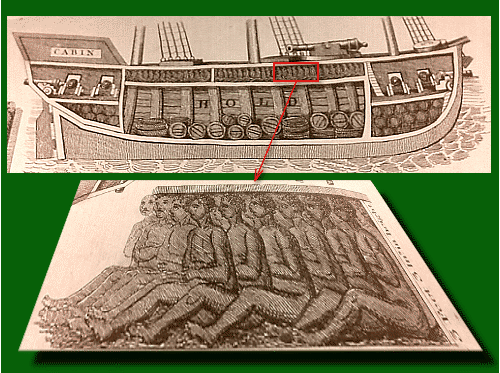The Portuguese were the first to encounter the Yoruba people
of present day Nigeria. They began trade with pepper in the 15th
century. [1] The slave trade came later. Gold was traded before slaves were traded. The
Europeans did not have the power at that time to overcome African states before
the late 19th century. The gold remained in the power of the Africans.
So, the European traded for gold in West Africa. Agreements were made between African and the
European elites for gold. Gold trading forts and stone castles were established
because of rivalries for African gold. The Europeans called this region the
gold coast. During the late 17th century the value of European goods
traded for African people surpassed the value of goods exchanged
for gold. As time passed these gold forts became slave forts.[2]
 | ||||
| Cape Coast Castle on Gold Coast In West Africa Image Image [1] |
 |
| Transatlantic Slave Trade Image [2] |
| Caribbean Slave Trade Image [3] |
The slave trade caused the political, economic and social elements to deteriorate in some West African states. The Oyo state in W. Nigeria collapsed during the slave trade era. Oyo was a Yoruba state, a main supplier of slaves in the 17th century Atlantic slave trade. Other West African states rose to prominence, such as the Asante’s. The amounts of gold mined in Asante is legendary. The development on the western hemisphere where the slaves were taken prospered.[5]
[1] "Nigeria History." Lonely Planet.
n.d. http://www.lonelyplanet.com/nigeria/history (accessed February 19, 2016).
[2] Behrendt, Stephen. "Transatlantic Slave Trade." Africana:
The Encyclopedia of the African and African American Experience, Second Edition,
edited by Ed. Kwame Anthony Appiah., edited by and Henry Louis Gates Jr... Oxford
African American Studies Center,
http://www.oxfordaasc.com/article/opr/t0002/e3861 (accessed Fri Feb 19 09:29:35
EST 2016).
[3]lbid.
[4] lbid.
[5] Reader, John. A Biography of the Continent of
Africa. New York: Alfred A. Knopf, Inc., 1997.
Images:
[1] Ley, Dave. "Description: Cape Coast Castle (a
Slave trading castle). Taken from atop the walls looking towards the main
building in the castle * Date: Fall, 2003 * Photographer: Dave Ley
Category:Ghana Category:Cape Coast [[Category:Sla." Wikimedia. 13
2005, JULY. https://commons.wikimedia.org/wiki/File:Cape_coast_castle_II.JPG
(accessed February 19, 2016).
[2] ''pt:''' Imagens mostrando como transportar
escravos em um navio negreiro *'''en:''' Images showing how to transport slaves
in a ship Fonte (source): Notices of Brazil, Walsh, 1831 ." Wikimedlia.
January 21, 2006.
https://upload.wikimedia.org/wikipedia/commons/4/4d/NavioNegreiro.gif
(accessed February 19, 2016).
[3] "African slavery in the caribbean image ." Yahoo
Search. n.d.
https://images.search.yahoo.com/images/view;_ylt=AwrB8pjiSsdWgB0An1EunIlQ;_ylu=X3oDMTIzZmE3aW0xBHNlYwNzcgRzbGsDaW1nBG9pZANlZmIwNWJjNGJiMmRmYWNiOTEzY2Y1ZThhMGQ0MWRjYgRncG9zAzEwBGl0A2Jpbmc-?.origin=&back=https%3A%2F%2Fimages.search.yahoo.com%2Fyhs%2Fsearch%
(accessed FEbruary 19, 2016).
No comments:
Post a Comment